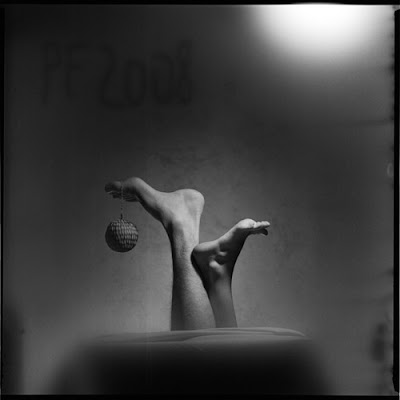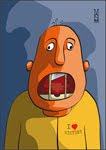From the other side: Rasťo Čambál
He began to respond to articles on my blog. Then we met for the first time. I was in the role of the translator. Then my lecture in his photo club FOPA followed. He said that I had to disclose the code of Hans Holbein to the club members. After that the meeting in my workshop took place. This way, step by step, I encountered a new person, that's a social network reality. He will reveal more by himself. Rasťo Čambál.
PF 2008
I heard you become photography addict from your youth with one 25 years long break. How did you encounter the photography as a teenager?
I think I encountered it in a very natural way. We had a Flexaret at home, my brother was using it and I tried it too. Simply as children copy activities of elders, I began to do what they did. Of course, if the activity would not amuse me, I would give it up. I took pictures of my family, friends, of my school environment and school trips. We had completely equipped dark room at home, so I did not have to search for the first experience far. I applied to photo club when I was in primary school. I do not remember how much I progressed in the club, probably not much. Surely I got basic craft skill there but not very high.
Why did your break last a quarter of a century? Don't you have a feeling, that you missed the most important time to your creative development?
Why so long break? You have to ask my cubhood :-) . Probably the most important impact on my life than had my interest in playing guitar. Of course, the reason behind it was a girl I fell in love with, and she played the guitar too. That was the beginning of my "musician period", and it lasted 18 years.
And did I really miss the period of creative development? Probably not, because I was involved in my own music, which demanded a lot of creativity, ideas and imagination. I don't want to say I was the only creative person in the group. We worked as a team. I learned there to exploit the alpha level – I exploit it when I create till today. 
My landscapes
The comebacks aren't easy. Didn't you feel that challenges could be too big for you after so long break?
No, I don't think so. Because I did not do creative photography when I was young I was therefore on the start line. A few years after I finished my music activities I felt lack of creative activities. I had positive relationship to computers so I decided to buy my first digital camera. That was the comeback to my interest in photography. It was just the beginning, right now I do a classic photography. I use different cameras for different sizes.
A job, family, photography. Is it possible to combine them all?
Yes, it is possible, with certain limitations. You have to set up priorities and then you act accordingly. My priorities put photography in a high position, but I know a few very good photographers, who don't do it. I think it's a pity. 
My landscapes 2
What motives attracted your lenses when you were young? Were they different from today's ones?
I used to take pictures of my schoolmates, but most pictures I took at home. My family. Sometimes I got some orders. Of course, nothing serious. It was all around my schoolmates and family.
Today you focus on man in your artwork. Do you think, that so unfathomable subject can be understood and expressed meaningfully?
I hope not :-). If I did it, what else could I do then? For me most important is searching connected to creating. As we say "The goal is not important, what is important is the way to the goal. There is a philosophy in it. Even if I search for something that has already been discovered. To me it is a process to know it myself. 
There is a motto in your first picture publication called Identity: "A good looking photography doesn't have to be good, and a good photography doesn't have to be good looking at all." How do you percept and differentiate the beauty and quality in photography? Where are the limits of your criteria defining the basic categories?
There was a time I strived for good looking pictures. And the people enjoyed them. I won several competitions that way. I noticed however that people responded mostly to pictorial form, not to the content. The beauty was in first plane. The content was in the second one. And my desire was to revert it. Then I realised that the beauty is the neighbour of the kitsch. So I excluded beauty from my pictures and began to put it into the content. I noticed I cannot rely on the general view of irony, parody or wit anymore but that I have to be genuine and it has to be about me, my opinions, feelings, that I have to undress completely in public. For me a good picture is the one which doesn't loose its value even after long time. When the picture is timeless. I prefer decadent pictorial form to let the content stand out.
I have a feeling from your work of art, that you want to testify about certain features of human character. Features which are very obvious but we pretend they don't exist, and if they do, then only in the lives of the other people, not in ours. Do you think your pictures bring about feelings of trying to stop disclosing the dark spots in human nature?
People generally don't like to reveal their hidden feelings and emotions. We are different in public and different in private lives. But in spite of this I think my pictures don't cause that kind of response. I rather think people have no desire to understand it, they resist to being genuine to themselves. For example, if we do something wrong, how many reasons to excuse ourselves we find and how much are we willing to admit our own mistakes? Many people find my pictures depressive and I have a suspicion that the only reason of it is that pictures are black and white.
Where do you search and discover the "readers" of your art work?
I don't search for "readers" of my art work. I don't create for a target group. I create mostly from my inner necessity. I am pleased with the fact my work meets positive response, but I don't have illusions about it. 
Identity
Symbolism is main content and means which you use to narrate austere stories. Do you think, that contemporary people who grewn up on the straightforward consumption of unassuming "culture" production can grasp the story you offer?
Probably not. We read symbols differently. Uneducated person can read it mostly based on his own life experience. And we all have our own. But I don't mind if a person finds his own story in the content of my photography. Most important is that he has a will to search for the story.
The contrast is another means of expression you use in your works. Do you follow any theory or rules of the game?
No, I do not follow any. I follow my intuition. Right now I am satisfied with wide range of gray scale. I don't use high contrast. I tend to leave out the white. 
Atlas
You are president of photo club in Galanta, member of photo club FOPA in Bratislava and member of Alliance of artists of western Slovakia. Can you tell us something about how they function, about the atmosphere and people there?
Everything depends on good will of the members to join the club activities and educate themselves. Nevertheless the education is not the main priority of the club. If the members have a good feelings from being there and are enjoying meetings with others, the purpose is fulfilled. Unfortunately I have to admit that activities of the club lay upon heads of a few people. I heard that similar clubs abroad have similar experience. It is simply human character. Otherwise I have no reason to complain. There are many photo activities during the year, I have to select.
You had a few exibitions of your artwork in the country and abroad. What message could you send to the world and what message did you get? Do you have a feedback?
I could only say that I exist. The feedback is not my main priority. Of course I'm glad whenever I get a positive response, who wouldn't be, but it is not the main thing to me.
You can find Rasťo and his pictures on http://www.rastcam.com/com/











